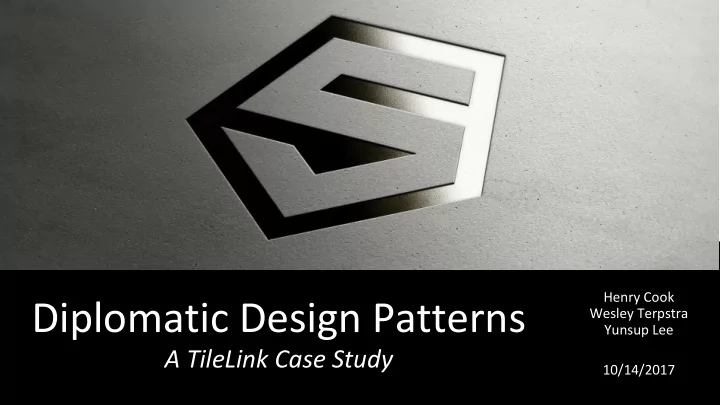

Henry Cook Diplomatic Design Patterns Wesley Terpstra Yunsup Lee A TileLink Case Study 10/14/2017
• Rocket-Chip Ecosystem • Diplomacy • TileLink • Design Patterns Agenda • DRYing out Parameterization • Generation with a View • Compositional Cake • Deployment 2 SiFive Confidential
The Rocket-Chip Ecosystem for RISC-V • Chisel • A Domain-Specific Language for hardware construction embedded in Scala • Rocket-Chip • A collection of hardware generators implemented in Chisel • Diplomacy • A Scala framework for negotiating parameters between Chisel generators • TileLink • A parameterized chip-scale shared-memory interconnect protocol 3
Diplomacy 4
When Chisel Isn’t Enough • We’d like to be able to see everything that will be in the system before we even start to emit any hardware descriptions • How early can we detect misconfiguration? • <> considered harmful • wire width inference can mask problems • Generators are nice... • but parameterization itself is a source of complexity • but each generator needs to agree with the others about what to generate 5
Diplomatic Parameterization • Graphical abstraction of interconnectivity • Directed Acyclic Graph (DAG) • Node • point where parameterized hardware is going to be generated • Edge • a directed pairing between a master and slave interface • Modules may have many nodes and nodes may have many edges 6
Simple Example Graph 7 SiFive Confidential
Actual ( small ) Rocket-Chip Graph TL to AXI Tile AXI to TL Peripherals TL to AXI 8 SiFive Confidential
What Parameters Can Be Diplomatic? • The cardinality of sources connected to a particular sink (transitive) • The cardinality of sinks connected to a particular source (transitive) • The type and size of operations issues by each master and slave • The type and size of operations allowed on a particular address • Other properties governing allowed behavior on particular regions (e.g. modifiability, executability, cacheability) • Ordering requirements on operations over subgraphs (e.g. FIFO) • Presence of certain fields within control wire bundles • Widths of fields within with control or data wire bundles • Presence of entire virtual networks or channels 9
How Diplomacy Negotiates • Two-phase elaboration • First, graph is created and parameters are negotiated (LazyModules) • Second, Chisel hardware is elaborated (Module implementations) • During the first (“diplomatic”) phase: • One set of parameters flow outwards from master to slave nodes • One set of parameters flow inwards from slave to master nodes • Adapter nodes can modify parameters flowing through them • All modules can place requirements on parameter values 10
Short Circuiting the Debug Loop • What happens when negotiation fails? • Error at Scala runtime • What doesn’t happen? • Chisel elaboration • Verilog emission • Verilog compilation • Simulation execution • Waveform debugging 11
TileLink 12
TileLink: Graphical Structure 13 SiFive Confidential
TileLink: Graphical Structure • Directed Acyclic Graph (DAG) (again) • Agent (Node) • point where messages are created • Link (Edge) • a directed pairing between two agents’ master and slave interface • Modules may have many agents and agents may have many links 14
TileLink: Directed Channels 15 SiFive Confidential
TileLink: Modularity • Spec defines threes levels of conformance • Rocket-Chip uses Diplomacy to achieve even finer granularity • Individual links specialized to the types of messages sent 16
TileLink: Composability • Generality of interfaces • All agents use the same transaction structure • Scalability rules for hierarchy • DAG prevents deadlock • Strict prioritization of channels • Necessary for individual transactions to make forward progress • Decoupled handshaking rules • Limit when and why messages can be rejected • Deadlock freedom and forward progress guarantees! 17
TileLink: Transaction Structure https://www.sifive.com/documentation/tilelink/tilelink-spec/ 18 SiFive Confidential
Design Patterns 19
DRYing out parameterization • Don’t Repeat Yourself • “Every piece of knowledge must have a single , unambiguous, authoritative representation within a system” 3 3 1 3 3 3 2 3 3 3 20
Hardware Generation With A View 21 SiFive Confidential
Combinational Composition • Thin adapters that each serve a specific, orthogonalized function • Zero-cycle response time is allowed (support is actually mandatory) • Simplify verification at no design cost 22
Combinational Composition • Modify control signals • fragment burst messages into a series of single beat messages • Modify message field widths • widen the width of the data bus plane • Manage inter-message transaction requirements • enforce FIFO ordering across a series of messages and responses 23
Sequential Composition • Decoupled nature of TileLink interfaces makes it easy to insert buffering at arbitrary point in the graph 24
Hierarchical Composition • Any sub-graph can be swapped out for a different sub-graph that provides the same properties • Inserting caches (or chains of caches) • Filtering addresses into banks • Transparently crossing clock domains • Transparently converting between protocols • Scala traits • Interfaces that can provide concrete members • Support multiple inheritance • Build a system from layered components (cake pattern) 25
Compositional Cake 26
Deployment 27
Rocket-Chip: 2017 Rewrite • Piecewise conversion to Diplomatic TileLink and AMBA • using adapters between sub-graphs with different protocol versions • Started from slaves and moved inward to masters • Took about 6 months to complete • Only remaining non-diplomatic Modules are the top-level test harness and leaf modules inside of the Rocket tiles 28
Future Work: Diplomacy • Automatic punching of IOs via cross-module edges • Ease arbitrary changes to granularity of module hierarchicalization • Conversion between clock domains • Cross at boundary of automatically inserted module wrappers • Lightweight support for interrupts and other simple types that need to be routed to arbitrary locations, including to top-level IOs • Diplomatic RoCC 29
Future Work: TileLink • Critical Word First for cache blocks • Richer performance hints • Cache coherence protocol parameterization • Deadlock freedom and forward progress proofs, formal models • ChipLink 30
31 SiFive Confidential
Recommend
More recommend